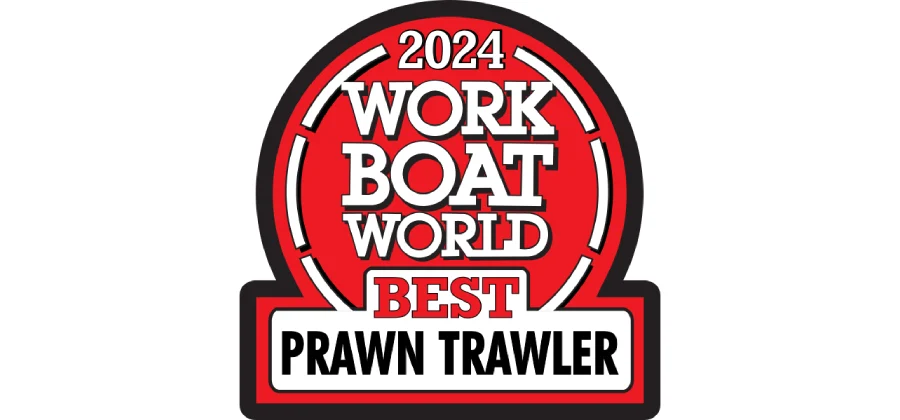AWARDS 2024 | Best Prawn Trawler – Forever Faithful – Macduff Ship Design & Macduff Shipyards
Having followed the design and construction of Scottish fishing boats for the past half century, it has been interesting and impressive to follow their evolution and refinement.
The ancestry and DNA of Forever Faithful is obvious and has led to this latest iteration of a chunky, solid, seaworthy and effective trawler to work the wild waters to the north of Scotland.
"It was designed in collaboration with Macduff Shipyards, with the Wolfson Unit in Southampton being commissioned to run a case study of two hull forms utilising CFD technology," Ian Ellis, Managing Director of Macduff Ship Design, told Baird Maritime.
"The first hull form was in fact the previous Forever Faithful, and the second was the new concept model featuring several developments aimed at improved efficiency and performance."
Results from the study indicated a significant reduction in hull resistance at the two test speeds of eight and 10 knots, which has been verified. The new vessel is able to steam around one knot faster at full engine power than the previous vessel, though both vessels have the same engine type and available power.
"The increase in hull efficiency enables the owner to run the engine at a lower loading to save fuel, and in turn, reduce the emissions and environmental impact of the vessel," said Ellis.
To further reduce its environmental impact, the propulsion package was very carefully considered. The vessel features a gearbox with a large 10:1 reduction, which Ellis said is the largest reduction ratio Macduff Shipyards has fitted to date with a fixed-pitch propeller.
"This gearbox and new hull form allowed the fitting of a 2.5-metre diameter propeller, fitted within a modern profile of nozzle duct, providing high thrust at low speeds but also a slight increase of thrust at steaming speeds too compared to the previous vessel."
"It features a unique layout within the accommodation and the fish processing area," added Macduff Shipyards Manager Matthew Watt. "This was done to enhance crew comfort and well-being, as well as provide economical use of space on the fish processing deck and a flow of product from the fish reception hopper through to the blast freezer compartment."
For Watt, the main challenge during construction came about during the process of creating a generous accommodation space whilst also fitting all the plant and equipment associated with a trawler that can freeze its product at sea.
"A blast freezer room is fitted above deck, with a special elevator to lower the frozen product into the cold store below. This allows the frozen product to go straight into the cold store without coming onto a space with warm temperatures which may damage the product."
"The layout of the vessel below deck remains largely unchanged from previous models but above main deck the accommodation and processing spaces have been revised to enhance crew comfort and operational efficiency and ergonomics," said Ellis. "The main challenges were related to the development work completed on the new hull form including the challenge to fit a larger propeller whilst maintaining vessel draught and improving water flow through to the propeller.
"Working between the teams at Macduff Ship Design, Macduff Shipyards and the Wolfson Unit brought about significant changes to the old hull form, thus resulting in a new form with significant efficiency improvements."
Ellis remarked that this development has since been utilised in the development of other vessels' hulls and has seen positive results in all cases.
"We find a drive towards efficiency and an interest in options for the use of 'green' technology," Ellis replied when asked about current trends in naval architecture. "With the majority of the vessels we are building at this time, there are few options for zero local emissions vessels due to the voyage cycle requirements inherent in their operation.
Ellis observed that this leads to a drive to improve the environmental impact in other ways by improving hull efficiency and utilising other technologies.
"We also see a drive to improve crew comfort and vessel motions. We therefore see improvements in crew welfare but also in crew efficiency, with personnel being able to work at a higher level when on board a more 'sea-friendly' vessel."
For Watt, the implementation of MARPOL emissions standards in relation to IMO Tier III has had an impact on the vessels built by Macduff Shipyards.
"The additional equipment required for the urea dosing systems have proven a challenge to fit into boats and small ships, in particular the tanks to carry a significant quantity of urea," he told Baird Maritime. "Fitting the systems has also been a bit of a learning curve for both the yard and the local engine suppliers in the UK."
Watt believes improvements in fuel efficiency and how energy is used on board vessels to be of increasing importance in the fishing vessel industry.
"Whilst future fuel technologies are still unclear for small workboats and fishing vessels, we have no doubt that regardless of the fuel selected, the key to a successful vessel will be consuming as little fuel as possible.
"It is hard to imagine that the cost per litre of alternatives fuels to diesel is going to be any cheaper. More likely they will be more expensive due to the processes required to create the fuels."
Ellis remarked that, with uncertainties and the lack of current viable alternatives to diesel propulsion, particularly within the trawling sector, coupled with other pressures on the fishing sector, there is less appetite for newbuild projects at this time.
"Those projects that are progressing are being driven by efficiency gains in the hull and machinery design and automation and by quality improvements in catch handling and storage," he told Baird Maritime. "There has also been an interest in extending current vessel life and capability with refit and vessel lengthening projects."
For a list of the 2024 "Best Of" award winners, please click here.





